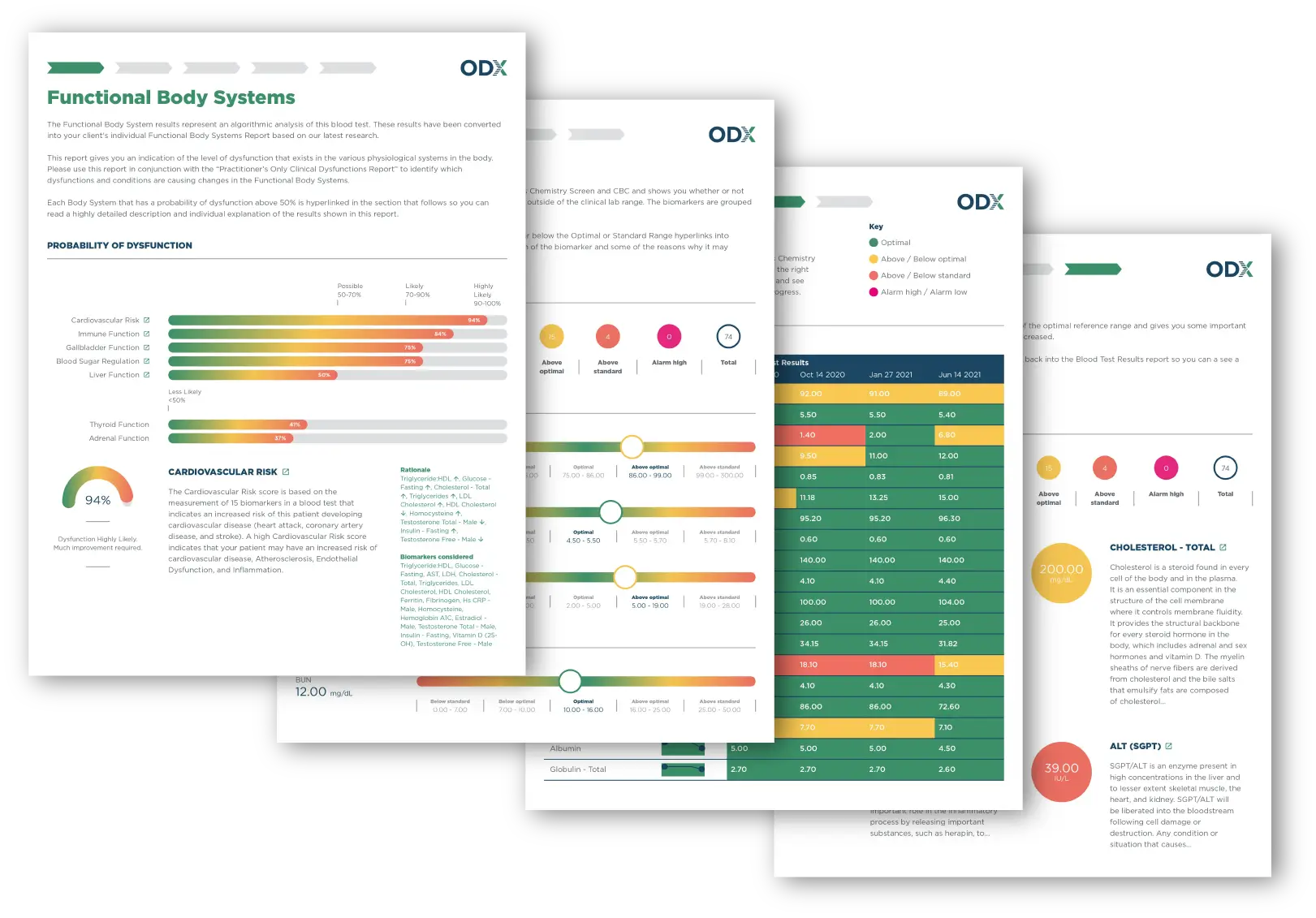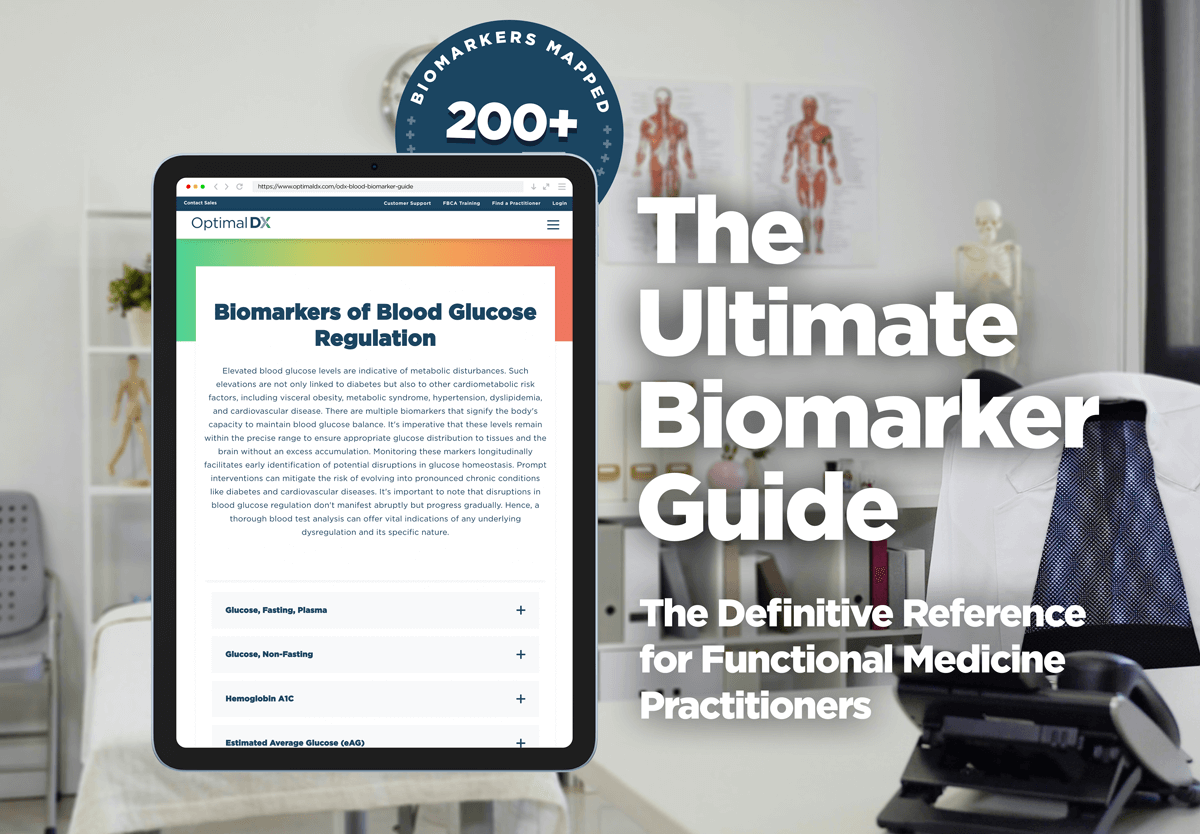
Functional Blood Chemistry Analysis, or FBCA, is a powerful tool for Naturopathic Physicians, Chiropractic Physicians, practitioners of Functional Medicine, nutritionists, health coaches and other members of the healthcare ecosystem to assess patients, identify dysfunction and treat it early.
The prevailing myth about blood chemistry analysis is that it’s a diagnostic tool only used for determining the presence or absence of disease. This, however, isn’t true. When conducted from a functional perspective, blood chemistry analysis can be an incredible method for preventing the evolution of dysfunction into disease. Applied correctly, FBCA can serve as a signpost on a patient’s journey to optimal health. Let’s explore how.

In 1852, German physiologist Karl Vierordt established the first method for conducting a blood count. The procedure was fairly rudimentary — a known volume of blood was extracted from the patient and spread over a microscope slide; the medical practitioner then counted every red blood cell in the microscope and extrapolated that number to reach an estimate of the number of red blood cells circulating through the patient’s body.
Not exactly useful. What's more, its tedious nature meant that this process wasn’t exactly feasible to do for every patient that might need a blood cell count.
Today, blood chemistry analysis provides a lot more information than just a count of circulating red blood cells. Medical practitioners regularly evaluate the levels of various biomarkers in the blood to detect the presence or absence of diseases of all stripes. If your fasting blood glucose comes back above 110 mg/dl, for example, your doctor might suspect that you have diabetes.

When you approach blood chemistry from the functional perspective, you gain a tool to identify and treat dysfunction before it manifests as a disease. Rather than wait for iron deficiency to become anemia or insulin insensitivity to become diabetes, Functional Medicine practitioners intervene early to avoid the negative health outcomes. Let’s explore some of the principles involved in FBCA.
In contrast to allopathic medicine’s focus on disease, the functional approach to blood chemistry is a patient-focused one.
An allopathic practitioner looks to categorize a patient’s symptoms under a specific disease to deploy a specific treatment plan tailored to that disease. This approach begins with disease and works back to the patient. Functional medicine does the opposite; it starts with the patient and their concerns, then works towards treating those concerns.
By building a holistic, comprehensive picture of their patients’ health, functional medicine practitioners provide treatment plans tailored to the patient. Ideally, this helps to prevent the disease from occurring in the first place. Going even further, it helps to prevent states of dysfunction — that is, those states of imperfect health that fall through the cracks of disease diagnosis.
If Functional Medicine differs from allopathic medicine in that it focuses on the patient rather than the disease, how is that reflected in blood chemistry?
Allopathic blood chemistry analysis relies on whether or not a given biomarker’s values are inside or outside of a laboratory’s reference range. These ranges are calculated based on the average values found within a sample population. Blood testing laboratories define “normal” as the values reflected in roughly 95% of their sample — the upper 2.5% and lower 2.5% are considered to be abnormal.
The problem here is that many practitioners only diagnose disease or dysfunction based on whether their patients’ blood tests fall outside of the broad range of values found within the 95% reference ranges. But these are statistical averages; not true markers of actual health.
Rather than say their patients’ blood biomarkers fall within “normal” limits that have very little to do with the individual's real health, Functional Medicine practitioners use blood chemistry analysis by looking at much tighter ranges. These functional blood chemistry ranges are empirically correlated with real health outcomes, and by tracking their patients’ progress toward or away from those ranges, practitioners help guide their patients toward optimal health — not merely “normal” health.
With the right tools and knowledge, practitioners use FBCA and functional blood chemistry ranges to recommend supplements, medication and/or lifestyle changes. If a patient’s fasting blood glucose is too high, for instance, the practitioner might recommend diet and exercise. On a follow-up test, the practitioner might observe that the patient’s fasting blood glucose is still high; since their recommended treatment didn’t have an impact, they might invest in further testing or modify their treatment plan.
Importantly, the practitioner would regularly test the patient’s blood to observe how their glucose levels evolve over time. FBCA is all about tracking trends. By taking multiple blood biomarker profiles, practitioners can see whether and how their treatment is making an impact.
FBCA also serves as a means of targeting future testing. Rather than recommend a battery of tests that run the gamut from mildly to majorly invasive, cheap to expensive, vague to precise, functional medicine practitioners can use a blood test — a non-invasive, cheap and informative test. If more testing is needed, the practitioner will have ruled out those tests that don’t seem likely to yield any pertinent results.
It’s certainly more useful than counting individual blood cells, and it's important to know that you've got diabetes so you can begin appropriate treatment. But wouldn't it be better to know that you're on the road to diabetes long before the actual disease manifests? Wouldn't it make sense to treat dysfunctional blood sugar regulation early to bring your body back to optimal levels?
For many licensed medical professionals, blood chemistry analysis feels like a tool that belongs squarely in the allopathic physician’s toolkit. This, however, isn’t the case. At Optimal DX alone, we’ve seen practitioners from a wide range of backgrounds adopt FBCA:
Licensed medical practitioners use FBCA to inform their treatment plans, refine their testing procedures and measure their patients’ health over time. Crucially, FBCA provides clear, actionable information for patients. By seeing the changes in their blood biomarker profile, patients gain a better understanding of where their health stands and how your treatment will improve it.
Though FBCA is most commonly seen in a medical practitioner’s office, non-licensed health professionals also stand to benefit from its use, including:

More than anybody else, FBCA is for the patient. They play the greatest role in the FBCA process, whether at a licensed medical practitioner’s clinic or an allied health professional’s practice.
Patients seek out FBCA in order to gain answers they aren’t finding from their allopathic physicians, who too often tell them that their test results are “normal” — despite the fact that they’re experiencing pain and discomfort.
Frustrated, patients look for practitioners that can offer an analytical and interpretive approach that starts with their lived experience and ends with a better health outcome. Patients may choose to undergo FBCA with a practitioner once and apply their treatment recommendations, or they may seek regular blood testing to monitor ongoing concerns. In either case, FBCA is an in-demand service that patients are sorely missing.

For many licensed medical professionals, blood chemistry analysis feels like a tool that belongs squarely in the allopathic physician’s toolkit. This, however, isn’t the case. At Optimal DX alone, we’ve seen practitioners from a wide range of backgrounds adopt FBCA:
Licensed medical practitioners use FBCA to inform their treatment plans, refine their testing procedures and measure their patients’ health over time. Crucially, FBCA provides clear, actionable information for patients. By seeing the changes in their blood biomarker profile, patients gain a better understanding of where their health stands and how your treatment will improve it.
Though FBCA is most commonly seen in a medical practitioner’s office, non-licensed health professionals also stand to benefit from its use, including:

More than anybody else, FBCA is for the patient. They play the greatest role in the FBCA process, whether at a licensed medical practitioner’s clinic or an allied health professional’s practice.
Patients seek out FBCA in order to gain answers they aren’t finding from their allopathic physicians, who too often tell them that their test results are “normal” — despite the fact that they’re experiencing pain and discomfort.
Frustrated, patients look for practitioners that can offer an analytical and interpretive approach that starts with their lived experience and ends with a better health outcome. Patients may choose to undergo FBCA with a practitioner once and apply their treatment recommendations, or they may seek regular blood testing to monitor ongoing concerns. In either case, FBCA is an in-demand service that patients are sorely missing.


Discover our comprehensive Biomarker Guide, your key to unlocking the secrets hidden within your patient's blood test results! With our guide, you'll gain valuable insights at a glance. Delve into the fascinating world of biomarkers, explore their ODX Ranges, and access detailed blog posts for in-depth knowledge. Uncover the wealth of research papers we've meticulously reviewed to create this invaluable resource just for you. It's time to empower yourself with knowledge like never before!
These benefits are all well and good in theory, but running a practice is just like running any other business: new changes need to be made with careful consideration and an eye towards implementation. To that end, let’s explore what FBCA is like in practice.
Step 1: Take a Blood Sample
Drawing blood is simple enough, but there’s more to this stage than that. First, you’ll need to determine what kind of blood test to order. For example, if your patient is new and doesn’t have any specific complaints, it could be a good idea to order a generic, full male- or female-oriented blood panel. (CLICK HERE for information on the recommended Optimal DX Panels) Or, your patient may have come to you complaining of fatigue. You may suspect some form of blood sugar dysregulation and should order a comprehensive metabolic panel as a result.
Step 2: Order the Chosen Blood Test
Next, you’ll want to send your blood sample to the laboratory of your choice, such as LabCorp or Quest.
For licensed professionals, blood testing can be ordered through the patient’s insurance plan — though this may limit which sorts of tests you can order. Alternatively, licensed and non-licensed practitioners alike can have their clients order blood testing through direct access testing (or DAT) if they operate within a state that permits DAT. CLICK HERE to see some of the lab companies we integrate with.
Most results will be available within 24 hours, but more complex panels may take 2-3 days or longer.
Step 3: Enter Lab Results into ODX
At Optimal DX, we have three ways to get lab results into your Optimal DX account:
Step 4: Let Optimal DX Analyze the Results
As established, it’s important to analyze the results from a functional perspective. Simply reading a lab report will only call out when results are out of the normal range, whether above it or below. Naturally, if a given biomarker is out of normal range, that will be clinically significant for you and your patient. But interpreting the results with a functional eye will provide you with more clinically relevant conclusions you can bring to your patient, even (especially) if a biomarker is within the normal range.
If you’re new to FBCA, this might be an intimidating step; fortunately, there are courses, reference materials and tools to help support your analysis. We dive deeper into this aspect of FBCA further down the page.
Step 5: Build a Treatment Plan
Step 6: Report Clinical Findings and Recommended Treatment Plan
Step 7: Follow-up and Track Change Over Time
After a few weeks have passed, you’ll want to schedule a follow-up visit. Now’s a great time to ask your patient whether they’ve experienced any improvements or deficits, how they’ve managed compliance with your treatment plan and to schedule additional testing.
Observing change over time is one of the major reasons to implement FBCA at your practice; whether a patient reports worsening symptoms or improving symptoms, it’s important to take the tests and evaluate whether or not that change is objective. After all, we all know how powerful the placebo effect can be.

Now that you know what FBCA is, how it can enhance your practice and the realities of implementing it, all you need is the knowledge and tools to carry it out.
Supplying practitioners with FBCA knowledge and tools is our mission at Optimal DX. We offer a variety of resources to deliver these essential ingredients to a successful practice.
Many medical practitioners may want to learn more about the "how" of FBCA before investigating further. For those practitioners, we recommend reviewing our guide, The FBCA Blueprint: How to Implement FBCA into Your Practice.
For practitioners who want to build up the fundamental, functional knowledge essential to this method of blood chemistry analysis, we recommend registering for our FBCA Mastery Training. Registrants gain:
One of the good problems that FBCA causes is an influx of patients and corresponding blood test results to track, analyze and interpret. That’s why we provide membership in the Optimal DX Platform. This platform:
Get Your ODX Membership Today!